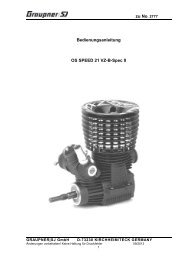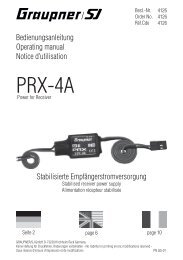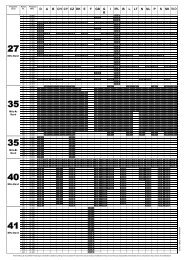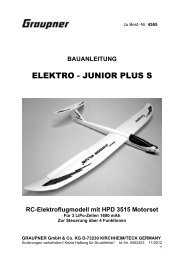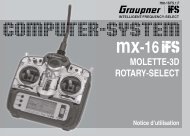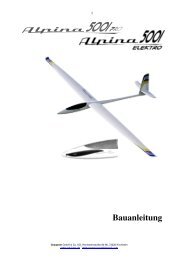Order No. 4451 Fuselage kit Order No. 4451.K ... - Graupner
Order No. 4451 Fuselage kit Order No. 4451.K ... - Graupner
Order No. 4451 Fuselage kit Order No. 4451.K ... - Graupner
Create successful ePaper yourself
Turn your PDF publications into a flip-book with our unique Google optimized e-Paper software.
UNI-STAR 60<br />
8. Gyro adjustment<br />
Gyro systems damp out unwanted rotational movements around the vertical (yaw) axis of the<br />
model helicopter. They do this by detecting the unwanted motion and injecting a<br />
compensatory signal into the tail rotor control system, and in order to achieve this effect the<br />
gyro electronics are connected between the tail rotor servo and the receiver. Many gyro<br />
systems also allow you to set two different values for gyro effect and switch between them<br />
from the transmitter via a supplementary channel. Some gyros even offer proportional<br />
control. The extra channel is controlled via a proportional slider or rotary knob, or a switch,<br />
depending on the gyro system.<br />
If your gyro system features an adjustor box with two rotary pots for two fixed settings, and<br />
you can switch between them from the transmitter, it is best to set one adjustor<br />
approximately to centre (50%), and the other to 25%. If the gyro system provides<br />
proportional control between the two set values, then the one pot should be set to "0", the<br />
other to about 80%.<br />
If you have a gyro system whose effect cannot be adjusted from the transmitter, i.e. there is<br />
only a single adjustor on the gyro electronics itself, the pot should be set to 50%<br />
effectiveness as a starting point.<br />
Check that the direction of the gyro’s compensatory action is correct, i.e. that it responds to a<br />
movement of the tail boom with a tail rotor response in the opposite direction. If this is not the<br />
case, any yaw movement of the model would be amplified by the gyro! Most gyro systems<br />
are fitted with a change-over switch which reverses its direction, and this must then be<br />
moved to the appropriate position. However, some systems have no such switch, and in this<br />
case the solution is to mount the gyro inverted.<br />
One factor which all gyro systems have in common is that flight testing is necessary in order<br />
to establish the optimum settings, as so many different influences affect the settings.<br />
The aim of the gyro adjustment process is to achieve as high a level of gyro stabilisation as<br />
possible, without the gyro causing the tail boom to oscillate.<br />
14





